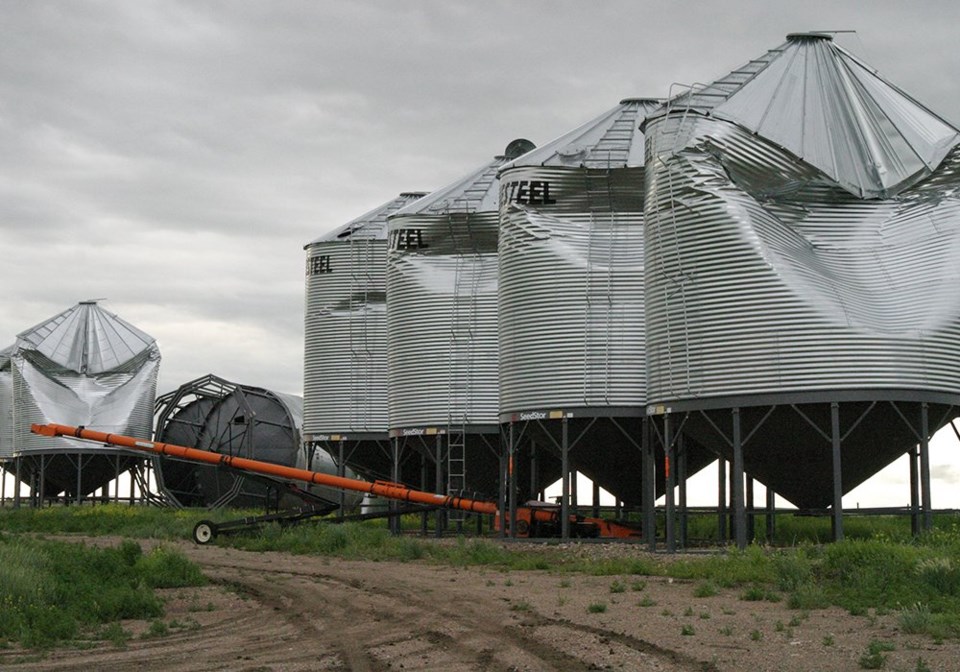WESTERN PRODUCER — If a big wind rattles and dents a big bin but doesn’t topple it, whether you hire a specialized repair crew or call in the bulldozer depends on your insurance policy.
If you have a policy that covers replacement at current prices, you’ll want the bulldozer. You’re paying premiums based on replacement, so you deserve replacement.
If for some reason you’re digging into your own pocket, you’ll be searching your phone for the name of that bin construction crew.
There’s a point at which the cost to repair exceeds the value of the bin, even if the damage doesn’t look that bad. Sometimes that bin has to come down, says Peter Wall, construction supervisor at Wall Grain.
Pete Wall (no relation to Dave Wall) has been in the bin erection and repair business for 15 years. He manages 10 crews across the three prairie provinces, totalling more than 100 specialized workers. They’ve been logging a lot of overtime this summer.
“The bins with the big eyebrow dent at the top can often be fixed, as long as the damage is confined to the top sheets. We’ve done quite a few of those over the last 10 years,” says Pete Wall.
“But if the roof is too badly damaged, then we have to knock it down, even if the walls look good. The roof has become a complex component. It’s not just to keep out the rain. Its other big job is to keep the bin round. A deformed bin is much more susceptible to wind damage.
“If the roof is damaged too badly, it’s not worth the expense to fix it. The cost of steel and labor is prohibitive. And it’s dangerous for the guys working up there. That’s always a big consideration.
“In the odd case where we do repair a roof, we put up scaffolding inside the bin. If the bin is higher than about 33 feet, then we bring in a crane to lift off the old roof. We build the new roof on the ground and use the crane to lift it up to the top. Roof replacement is typically a $30,000 project. If you replace that bin yourself, keep in mind there might be $10,000 worth of bolts and nuts. If we knock it down, we do save the aeration floor and the un-loader. But it’s a conundrum. My best advice is to make sure you have full replacement insurance. It eliminates these debates.”
He says scrap value is pretty minimal. They often get $100 or $200 a ton, which may reflect the market value. However, the actual cheque isn’t all that big because the panels are thin, so there isn’t a great tonnage. A bin might fetch $2,000 scrap value, but the labor is $1,000. He says it’s all chicken feed when you’re dealing with the new bin that might be worth $100,000. The general rule of thumb is that a bin gets scrapped if more than a third is damaged.
Sometimes wind punches a big dent in the side of the bin, like a giant fist has slammed the steel. The sheets adjacent to the dent are intact and the roof is intact. In these situations, if the sheets have been stressed, the farmers can insist on a new bin. There’s no way of confirming whether the structural integrity has been compromised.
“There is one situation where we repair these dents. That’s when we have an isolated big dent and it’s confined to one spot and hasn’t affected the roof.
“We had a whole row of stiffened bins this year where the wind had just (inched a certain spot on each bin wall. It pushed the steel in a little bit and bent two stiffeners. We just took out the bad sheets and put in new sheets and replace the two stiffeners. For $10,000 or $15,000 we can fix those dents and the bin is as good as new.”
Rusty aeration floors are another problem Wall encounters every year in bins with crops that haven’t been managed properly. If grain sits in the bin too long, it attracts moisture and it sweats. Frozen damp grain in the winter freezes. The floor panels might be galvanized, but that’s not a guarantee against rust.
“We’ve worked in bins where we’ve encountered a thick layer of solidified sludge on the aeration floor. It’s old, old crop that has gone mouldy and been frozen hard. There’s absolutely no air passing through those perforations. In some bins, we’ve had to scrape away two inches of that crap. In a 36- or 42-foot bin, that’s a lot of labour. When we finally get down to the floor panels and look underneath, everything’s rusty.”
He adds that rust from the panels will continue to grow and possibly affect the bottom of the walls, thus compromising the structural integrity of the entire bin.
Definitions
- Wind shear: Wind that moves at a different speed or direction in a short distance. This is a hazard for aircraft in particular. Inside a thunderstorm, wind shear can be the driver of extreme events such as tornadoes.
- Tornado: As warm, humid air spirals up from the ground into the towering clouds of a thunderstorm, it meets cold air rotating down to replace it. As the spinning builds momentum, it can generate a tight funnel with incredible destructive power.
- EF scale: Tornados are rated on the Enhanced Fujita five-point scale. EF0 tornados feature winds of 65 to 115 km-h, resulting in light damage. EF5 winds blow at about 420 to 500 km-h, capable of tearing houses from foundations and bark from trees.
- Plow wind: These strong downdrafts (also called derechos or downbursts) are born in thunderstorms. They pull cool air from high altitude and push it down and outward along a storm’s squall line, which can cover kilometres. With winds ranging from 100 km-h to more than 170 km-h, they can have force equal to some tornadoes.


